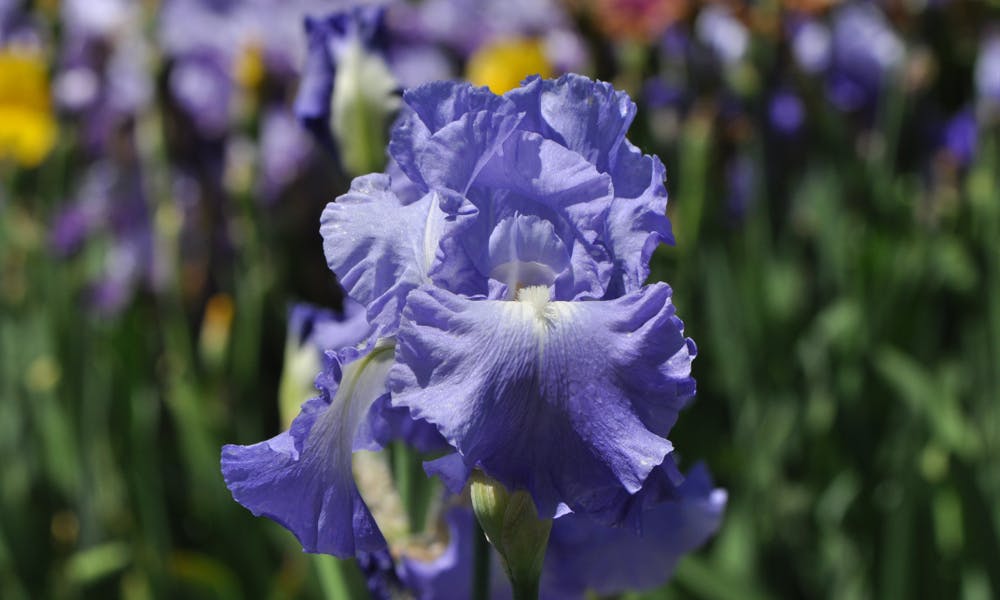MENU
The Iris – Tennessee’s Cherished Beauty

The state of Tennessee had many official state flowers over the years. The current state flower is the beautiful iris germanica or iris for short. This stunning flower is the most popular and loved garden flower that blooms in spring, coming in a wide variety of sizes and brilliant colors. In this article, we discuss the following:
* How did the iris become the state’s official flower?
* Origin and characteristics of the iris flower
* Symbolistic meaning of the iris
* Uses for the iris flower
How Did It Become Tennessee’s Official State Flower?
At the beginning of the 1930s, in the state of Tennessee, a wave of gardening came across the residents of this state. Gardening lovers started sharing their passion with their neighbors and friends, and eventually, proposed to the legislature to choose a state flower. The lawmakers obliged, and the stunning iris was chosen, but there was a catch: Tennessee already had an official state flower.
Previously, the passionflower was the state’s official flower, and school children chose it. The new designation didn’t please the passionflower’s enthusiasts. Because of that, the discussion regarding which flower should be designated had fallen in perpetual limbo for 40 years.
Eventually, the state legislature made a compromise in the year 1973 to designate the iris as Tennessee’s official state cultivated flower.
In spring, the people of Chattanooga to Knoxville organize the annual Iris Festival in honor of the flower, enjoying activities like a rodeo, a floral show, and the coronation of the Iris queen. The flower also appears on Tennessee’s license plate, and the iris is even subject to one of the state’s songs, named “When it’s Iris Time in Tennessee.
Origin and Characteristics of the Iris Flower
This exquisite flower belongs to a subfamily that includes more than 260 species. It’s a flowery plant with beautiful, colorful, and showy flowers.
The name derives from the Greek word “iris,” which means “rainbow,” due to their colorful aspect and a wide variety of colors, and in Ancient Greece, the goddess of rainbows actually bears the name “Iris.” This name is also commonly used for all iris types.
They are perennial flowers, which means that they live for more than two years, and they grow either from rhizomes or in dryer climates, from bulbs. Their stems are long, upright flowering stems, being simple or branched, hollow or solid, with a circular cross-section or flattened.
The brilliant colors they display come in a plethora of variations, from pink, brown, purple, blue, white, black, or yellow, each of this variation conveying different symbolic meanings, and given as a gift, can carry deep emotions to the other person.
The Iris germanica, which is the genus associated with the official state flower of Tennessee, is large and comes with bright purple or white coloring. They originated in central and southern Europe, and they are the best-known variety of this stunning plant. They can be cultivated all over the world and can be found naturally growing in Europe, North America, The Middle East, northern Africa, and Asia.
Symbolistic Meaning of the Iris
The brilliantly colored flowers are a symbol of admiration, courage, wisdom, hope, and faith. They convey powerful emotions when given as a gift, and with over 200 different variations, there is a wide variety of options to choose from. Different shapes and sizes, multiple bright colors, and deep meanings attached to them, this can be a beautiful way to convey and display your emotions.
The convenience and resilience of this plant allow it to grow in virtually any part of the globe, both naturally and in farms. The most common irises encountered are the flower’s cut version, which is white, blue, or yellow. Due to the wide variety of colors available, they symbolize different things, like the dark blue or purple iris representing royalty, and the yellow iris conveying passion.
They have a rich history, dating back to Ancient Greece and their mythological culture. The Greek goddess Iris was the messenger of the gods, and the embodiment of the rainbow, and acted as the link between earth and heaven.
This breathtaking flower was admired by Ancient Egyptian kings, and drawings of irises were discovered in many different Egyptian locations. They revered this flower and marveled at its exotic beauty.
Uses for the Iris Flower
In ancient times, this flower was used to make perfumes and medicine, and it is still practiced to this day. Ancient Greeks planted purple irises over womens’ graves so that the Iris goddess can come and guide them through the afterlife.
The essential oils derived from iris flowers are sometimes used in aromatherapy as sedative medicines, and dried rhizomes are often given to babies to help the process of teething. They are also used in flavoring and coloring different gins, such as Magellan Gin and Bombay Sapphire, using the orris root from the bearded irises, such as iris germanica and iris pallida.
The orris roots can also be dried and aged for up to five years. This process leads to the fats and oils contained inside to degrade and undergo the process of oxygenation, producing many fragrances used in the perfumery, giving a similar scent as that of violets.
The iris rhizomes can also be toxic, containing amounts of terpenes and organic acids, like myristic acids and ascorbic acids. These can induce skin irritation, nausea, vomiting, and diarrhea when ingested, but these are commonly not fatal. They should only be used under professional guidance and only for medical purposes.
They can also be useful in water purification by using the roots of the yellow iris. Their roots are planted in lava stone in a reed bed setup. This process can improve the quality of the water by consuming nutrient pollutants. These can also clog natural waterways, being an aggressive grower, and are actually banned in certain U.S. states.

